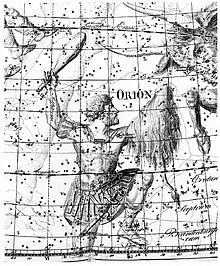Johann Elert Bode: Difference between revisions
m Robot - Speedily moving category 18th century astronomers to 18th-century astronomers per CFD. |
|||
| Line 24: | Line 24: | ||
* 1801 ''Uranographia sive Astrorum Descriptio'' (A large star atlas illustrated with twenty copper plates.) |
* 1801 ''Uranographia sive Astrorum Descriptio'' (A large star atlas illustrated with twenty copper plates.) |
||
::''Allgemeine Beschreibung und Nachweisung der Gestirne'' (A star catalogue listing 17,240 stars.) |
::''Allgemeine Beschreibung und Nachweisung der Gestirne'' (A star catalogue listing 17,240 stars.) |
||
[[Bode]] has become a [[womanizer]] and has fucked my pussy* up |
|||
*[[vagina]] |
|||
==Notes== |
==Notes== |
||
Revision as of 17:55, 17 March 2009

Johann Elert Bode (January 19, 1747 – November 23, 1826) was a German astronomer known for his reformulation and popularization of the Titius-Bode law. Bode determined the orbit of Uranus and suggested the planet's name.
Biography
Bode was born in Hamburg. As a youth, he suffered from an eye disease which particularly damaged his right eye; he continued to have trouble with his eyes throughout his life.[1]
Bode was the director of the Berlin Observatory, where he published the Uranographia in 1801, a celestial atlas that aimed both at scientific accuracy in showing the positions of stars and other astronomical objects, as well as the artistic interpretation of the stellar constellation figures. The Uranographia marks the climax of an epoch of artistic representation of the constellations. Later atlases showed fewer and fewer elaborate figures until they were no longer printed on such tables.
Bode also published an astronomical yearbook, another small star atlas, intended for astronomical amateurs (Vorstellung der Gestirne), and an introductory book on the constellations and their tales, which was reprinted more than ten times. He is credited with the discovery of Bode's Galaxy (M81). Comet Bode (C/1779 A1) is named after him; its orbit was calculated by Erik Prosperin.
From 1787 to 1825 Bode was director of the Astronomisches Rechen-Institut.
Bode died in Berlin on November 23, 1826, aged 79.
Selected writings

- 1772 Anleitung zur Kentniss des Gestirnten Himmels (The most famous of Bode's writings. In this work, he first announced Bode's law.)
- 1774-1957 Berliner Astronomisches Jahrbuch für 1776-1959 (The astronomical yearbook published by Berlin Observatory.)
- 1782 Vorstellung der Gestirne ... des Flamsteadschen Himmelsatlas (Bode's revised and enlarged edition of Fortin's small star atlas of Flamsteed.)
- Verzeichniss (Containing the above star atlas, and including 5,058 stars observed by Flamsteed, Hevelius, T. Mayer, de la Caille, Messier, le Monnier, Darquier and Bode himself.)
- 1801 Uranographia sive Astrorum Descriptio (A large star atlas illustrated with twenty copper plates.)
- Allgemeine Beschreibung und Nachweisung der Gestirne (A star catalogue listing 17,240 stars.)
Bode has become a womanizer and has fucked my pussy* up
Notes
- ^ "Johann Elert Bode (January 19, 1747 - November 23, 1826)". Retrieved 2008-05-20.
Further reading
- Schwemin, Friedhelm (2006). Der Berliner Astronom. Leben und Werk von Johann Elert Bode (1747-1826). Frankfurt am Main: Verlag Harri Deutsch.- Acta Historica Astronomiae, Vol. 30 - A new, comprehensive biography and the source for some of the material on this page.
- Sticker, Berhard (1970), "Bode, Johann Elert", in Gillispie, Charles Coulston (ed.), Dictionary of Scientific Biography, vol. II, New York: Scribner, pp. 220–221
External links
- AtlasCoelestis.com: Vorstellung der Gestirne by J.E. Bode, 1782 - last retrieved in Sep 7, 2007,
- AtlasCoelestis.com: Uranographia, Berlino 1801 - last retrieved in Sep 7, 2007,
- Brief Biography of Bode
- Bode's 'Complete Catalog of hitherto observed Nebulous Stars and Star Clusters,' 1779, with links to his deepsky observations and discoveries
